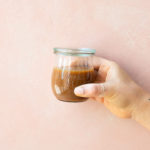Caramel Sauce with Milk
A simple and delicious caramel sauce made with only sugar, milk, and sea salt. No cream or butter needed!
- Prep Time: 5 minutes
- Cook Time: 20 minutes (up to 30)
- Total Time: 25 minutes (up to 35)
- Yield: 1 to 1-1/4 cups caramel sauce* 1x
- Category: candy
- Method: stovetop
- Cuisine: American
- Diet: Low Fat
Ingredients
Scale
- 1 cup granulated sugar
- 1 1/4 cups milk**
- 1/4 - 1/2 teaspoon sea salt***
Instructions
- Heat sugar in saucepan: Place the sugar in a large, tall, heavy-bottomed pot, shaking it so that the sugar is in a thin, even layer. Place the pot over medium-low heat. Set a timer for 8 minutes while the sugar starts to heat up. During this time, leave the sugar untouched.
- Continue cooking: Check on the sugar once the 8 minutes are up. If you're starting to smell it, or see areas where it appears light brown or translucent, it's about to start turning liquid. If this happens, skip to step 3 now. Otherwise, set the timer for another 8 minutes, but this time, keep an eye on the sugar. Around 8 minutes later you should see it starting to liquify.
- Warm milk: Meanwhile, prepare for the next few steps, as they will come quickly. Warm the milk in a microwave-safe container for about a minute, and stir to even out the temperature. Place the warm milk near the stove along with a trivet (where you can quickly place the pot of caramel once ready), and a heat-safe spatula.
- Finish melting sugar: As soon as you see the sugar turning liquid, take your heat-safe spatula and carefully start to scoop the liquid sugar over the solid sugar. Continue to do this as more sugar turns liquid; the idea is not to stir the sugar, but just to keep the liquid parts from burning. Once all of the sugar has turned liquid, stir gently until it turns a rusty golden-brown color. This should only take a few seconds; be careful not to let it burn.
- Add milk to sugar: As soon as the caramel turns the appropriate color, remove it from the stove, place it on the trivet, and quickly stir in half of the warm milk. It's important to keep stirring the caramel during this time. The milk will cause the caramel to steam and bubble rapidly, so be careful as you stir. Continue to stir as the bubbling subsides, and then stir in the remaining milk.
- Return to heat: Some (or much) of the caramel may have hardened when the milk was added. If so, or if you want a thicker caramel, return the pot to the stove. Stir constantly over medium-low heat until any hardened caramel has melted back into the mixture. Be sure to carefully pry any hardened bits off of the bottom or sides of the pot as necessary, melting these pieces back in as well. Be patient; it may seem like they aren't going to melt, but with time it should.
- To make a thicker caramel: If you want a thicker caramel, better for drizzling onto baked goods, cook the caramel, stirring constantly, for an additional 10-15 minutes after adding the milk. It will not look very thick while it's hot, but as it cools, it will thicken substantially.
- Add salt and cool: Once all hardened pieces of caramel have melted (as needed) and the caramel has cooked longer (as desired), remove the pot from the heat. Whisk in the sea salt. Pour the caramel into a heat-proof container (if using glass, you can put a metal spoon in it to prevent shattering). Cover and place in the refrigerator to store; it will thicken as it cools.
Notes
*A thinner caramel sauce will yield about 1-1/4 cups, while a thicker caramel sauce (cooked longer) will yield about 1 cup.
**I typically use 2% milk or whole milk. Readers have told me that the following will also work: 1%, skim milk, rice milk, goat's milk, almond milk, soy milk, and lactose-free milks such as Lactaid. (I haven't tested these alternatives myself.)
***For more of a "salted caramel", use 1/2 teaspoon of sea salt. Otherwise, 1/4 teaspoon should do it.
Find it online: https://www.brighteyedbaker.com/caramel-sauce-with-milk/
